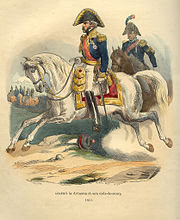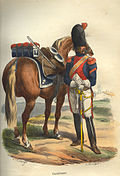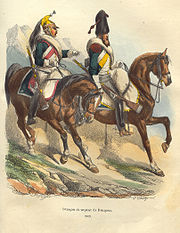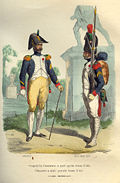

A General of Division, followed by an Aide-de-camp.
The uniforms of La Grande Armée, the army of Napoleon I, are described in this article.
Troops of the Line[]
Infantry of the Line and light infantry[]

Grenadier (left) and voltigeur (right) of the line infantry.
From 1793, the uniforms of the demi-brigades of the line infantry wore the blue "National Uniform" that was to be worn by all soldiers. However, for a long time, line infantry were a mix of the new blue coats worn by the National Guard and the white uniforms of seasoned veterans from the old Royal army. The blue dress was named the "National Uniform" and was worn by all line infantry by 1796. While headgear and details in cut changed, the uniform remained almost completely the same from the beginning of the French Revolution.
The uniform was made of a blue coat, red piped white collar and cuffs, white piped red lapels, blue piped red cuff flaps and shoulder straps, white turnbacks piped red, and brass buttons. Only the brass buttons had the units' identification numbers stamped on them. The lapels were fastened at the upper chest but sloped away below. The hat, a black felt bicorne, was the standard infantry headdress at some of Napoleon's greatest battles. In 1807, the hat was replaced by the shako, which was made of black felt, chevron on the side and visor, a brass diamond shaped plate stamped with the Imperial eagle over the unit's regimental number, white cords, and brass chin scales. Napoleon experimented with a few units by reintroducing white coats with facings of different colours specific to each unit (reminiscent of the old Royal army's coats), but these proved unpopular.[1]
Some units added pompons to the shako as well as plumes. Many units had pompoms with a houpette and the center generally colored white with the company number printed in black or red. The diamond shaped plate with the regimental was most common, but some units had the shape of an eagle or the rising sun.
In 1812, the cut of the coat was changed into a coatee that included short tails, a blue crowned N on the turnbacks, and the lapels fastened down to the waist and cut square. The waistcoat was made higher and was therefore not visible. The black gaiters came up to below the knees. The plate on the shako was now a crowned eagle over a semicircle with the regimental number inscribed on it.

Voltigeur and carabinier of the light infantry.
Infantrymen carried the 1777 charleville musket that had a bayonet with a 406 mm blade. The black leather M. 1801 cartridge box held 35 rounds of ammunition and was carried by a white buff shoulder belt; that for fusiliers had a frog for the bayonet. The cartridge box flap generally had a white linen cover and the forage cap was rolled under the box with red tassel hanging out. The M. 1801 knapsack was made of cow hide with two straps (later three straps) to hold the rolled greatcoat on the top.
The Grenadiers uniform was almost exactly the same as that of the fusiliers, except for red epaulettes and grenades worn on the turnbacks. They wore a bearskin cap with a brass plate stamped with a flaming grenade on the front, red cords and plume, and a red back patch with a white cross. The epaulettes broadened their shoulders and the tall bearskins made them look even taller. Moustaches were also mandatory. There were several variations that included a blue and red quartered back, white cords and a peak. This variation's headdress was a bicorne with a red pompom.
Voltigeurs wore a yellow-buff collar, green epaulettes with a yellow crescent, and yellow-buff bugle horns on the turnbacks. From 1804, they wore shakos, but some had bicorne hats with green pompoms and a yellow brush. By 1807, all Voltigeurs had a shako which could be plain black, and have a yellow top or bottom band, or have yellow chevrons, green cords, and an all-green plume or a green plume with a yellow tip.
Every regiment had a squad of Sappers who were generally dressed as grenadiers with red epaulettes and a cross axes badge on the upper sleeves, a bearskin cap with red cords and feather but no plate. They were equipped with a long leather apron, white gauntlet gloves, and an axe with a brass mounted handle. It was customary for sappers to grow beards.
Officers wore the same uniform as their men but it was of better quality. Their brass buttons were gilt, they had epaulettes according to their rank, and, on duty, they had a gilt gorget with a silver badge, generally a crowned eagle. Their turnback ornaments were identical to those of other ranks but in gold, while the battalion staff had grenades. Instead of gaiters, they wore black boots. Officers' bicornes had gold cockade loops and sometimes gold tassels at the end. Bearskin caps had gold cords, and a plate and cross on the back patch. Shakos had gilt plates and chin scales, gold bands and sometimes chevrons. Plumes and pompons were colored in the company's color or white if on regimental staff. Drummers had basically the same uniform as their company with tricolor, yellow, or orange lace edgings, red wings edged with lace, and a bass drum with medium blue hoops and white belts.
Heavy Cavalry[]
Carabiniers[]

Horse carabinier's uniform before 1809

Horse carabinier as of 1809
The corps of Carabiniers was a group of heavy cavalry originally created by Louis XIV. From 1791 to 1809, their uniforms consisted of a blue coat with a blue piped red collar, red cuffs, lapels and turnbacks with white grenades, red epaulattes with edged white straps, red cuff flaps for the 1st Regiment, blue piped red for the 2nd; pewter buttons, a white waistcoast, buff breeches, high boots, a black bearskin cap, white cords, a red patch with a white cross, a red plume, metal white chin scales from 1809, yellow-buff edged white belts, white gauntlet gloves, blue cloaks, and white sheepskin edged red. They woe white long gaiters for service on foot and blue overalls for undress. Carabiniers were armed with a dragoon musket with a bayonet and sword. The regiments rode black horses while trumpeters rode greys.
Trumpeters wore reversed colors, a red coat with a red collar, silver cuffs edged blue, lapels and turnbacks, silver and blue epaulettes, as well as other items described above.
In 1809, their uniforms were completely modified and saw the introduction of helmets and cuirasses. They wore an all-white uniform with light blue facings and red épaulettes. They wore a brass cuirass and a brass helmet with a red woolen crest named chenille (caterpillar, in French), a sealskin turban, black leather visor and brass chin scales.
| Regiment | Coats | Colars & Turnbacks | Cuffs | Cuff flaps |
|---|---|---|---|---|
| 1st Carabiniers | ||||
| 2nd Carabiniers |
Cuirassiers[]

French Cuirassier
The Cuirassier's uniform consisted of a blue coat with long tails until 1804, when all Cuirassier regiments began to wear cuirasses and helmets. The helmet was made of polished steel with brass comb, a black mane, a black cow-hide turban, black visor edged with brass, a red plume in a small brass socket on the left side, and brass chin scales. Senior officers had white plumes and gilded brass. The cuirass had front and back plates made of polished steel and had leather straps with brass scales, brass studs and fittings and the cuirass lining was edged with white in all regiments. Cuirassiers were armed with a straight-bladed cavalry sword, carbine and a pistol from 1806.
The uniform of the trumpeters from 1804 consisted of a helmet with a red or white mane, a blue single-breasted coatee with cuffs and a collar edged with silver or white lace, and white lace at buttonholes on the front. Before 1810, the trumpeters of the 1st and 4th trumpeters had a white helmet mane, a red plume, a red coatee, red collar and cuffs edged silver, white turnbacks with red grenades, seven laces on the chests, and red epaulettes. The 6th regiment in circa 1810-1812 wore a white helmet mane and red plume, a blue coatee with orange edged silver cuffs and collar, red epaulattes with a white crescent, and orange laces on the chest. The 7th regiment wore a yellow coatee and the 8th regiment wore an orange one. The 13th regiment, in 1812, wore a white helmet mane, a wine red coatee with five white laces in front. They did not wear the cuirass and were mounted on white and gray horses.
| Regiment | Coats | Colars & Turnbacks | Cuffs | Cuff flaps |
|---|---|---|---|---|
| 1st Cuirassiers | ||||
| 2nd Cuirassiers | ||||
| 3rd Cuirassiers | ||||
| 4th Cuirassiers | ||||
| 5th Cuirassiers | ||||
| 6th Cuirassiers | ||||
| 7th Cuirassiers | ||||
| 8th Cuirassiers | ||||
| 9th Cuirassiers | ||||
| 10th Cuirassiers | ||||
| 11th Cuirassiers | ||||
| 12th Cuirassiers | ||||
| 13th Cuirassiers | ||||
| 14th Cuirassiers |
Line cavalry[]
Dragoons[]

A Dragoon and a sapper of the dragoon of the line
The uniform of the Dragoon consisted of a green coat with turnbacks and lapels of the regimental facing color, and the collar, cuffs, cuff flaps, and piping edging the facings either of the facings color or green depending on the regiment, green shoulder straps piped with the facing color, yet many regiments wore white epaulattes instead, turnbacks with green grenades, pewter buttons, a white waistcoat and breeches, black long boots, a brass helmet with a brass crest, a black helmet mane, a sealskin turban, black leather visor, the plume varied (see below), brass chin scales, a bearskin cap with a red plume, red and white cords, a red back panel with a white cross, red epaulettes for elite companies, a green surtout and green stable jacket, a green forage cap piped the facing color, white lace and grenade, white duck trousers, grey overalls with buttons on the side, white gauntlet gloves, an off-white cloak, and green housing edged white with white number. Sappers wore bearskin caps with red cords, plumes, and a back panel with a white cross, red epaulattes, red crossed axes on the upper sleeves, and a white or buff apron.
From February 1812, the coatee remained the same colour while plumes were no longer issued for helmets. Instead, pompoms coloured red, sky blue, orange, and violet were issued for the first company of each squadron. These same colors were used for the white centre of the second companies. They were armed with a Dragoon musket with a bayonet and a sword.
Officers wore silver buttons and lace, gilded brass on their helmets, a turban of leopard fur (usually an imitation) that often went over the visor, and white plumes for the senior officers.
Trumpeters wore reversed colors, facing sometimes edged with white lace, a coat often single-breasted with white buttonholes in front, no cuff flaps, white epaulettes, and a white of red mane on the helmet. The same dress was used for the Foot Dragoons but with brass drums with blue hoops instead of trumpets. They rode white and grey horses.
| Regiment | Coats | Colars | Turnbacks | Cuffs | Cuff flaps |
|---|---|---|---|---|---|
| 1st Dragoons | |||||
| 2nd Dragoons | |||||
| 3rd Dragoons | |||||
| 4th Dragoons | |||||
| 5th Dragoons | |||||
| 6th Dragoons | |||||
| 7th Dragoons | |||||
| 8th Dragoons | |||||
| 9th Dragoons | |||||
| 10th Dragoons | |||||
| 11th Dragoons | |||||
| 12th Dragoons | |||||
| 13th Dragoons | |||||
| 14th Dragoons | |||||
| 15th Dragoons | |||||
| 16th Dragoons | |||||
| 17th Dragoons | |||||
| 18th Dragoons | |||||
| 19th Dragoons | |||||
| 20th Dragoons | |||||
| 21st Dragoons | |||||
| 22nd Dragoons | |||||
| 23rd Dragoons | |||||
| 24th Dragoons | |||||
| 25th Dragoons | |||||
| 26th Dragoons | |||||
| 27th Dragoons | |||||
| 28th Dragoons | |||||
| 29th Dragoons | |||||
| 30th Dragoons |
Chevau-legers lanciers[]

2nd Chevau-léger of the line
The uniform of the light cavalry (or chevau-legers) of the line consisted of a green coat with turnbacks and lapels of the regimental facing color, which could be crimson, red, blue, pink or yellow. The collar and cuffs were of the facings color, the green shoulder straps and the breeches were piped with the facing color. the uniform comprised pewter buttons, black boots, a brass helmet with a brass crest supporting a woolen crest named chenille (caterpillar, in French), a sealskin turban, black leather visor, brass chin scales and red epaulettes for elite companies.
| Regiment | Coats | Facings |
|---|---|---|
| 1st Chevau-leger | ||
| 2nd Chevau-leger | ||
| 3rd Chevau-leger | ||
| 4th Chevau-leger | ||
| 5th Chevau-leger | ||
| 6th Chevau-leger |
Light cavalry[]
Hussars[]

Hussar of the 4th regiment
The uniform of the Napoleonic hussars included the pelisse: a short fur edged jacket which was often worn slung over one shoulder in the style of a cape, and was fastened with a cord. This garment was extensively adorned with braiding (often gold or silver for officers) and several rows of multiple buttons. Under it was worn the dolman or tunic which was also decorated in braid. On active service the hussar normally wore reinforced breeches which had leather on the inside of the leg to prevent them from wearing due to the extensive riding in the saddle. On the outside of such breeches, running up the outside was a row of buttons, and sometimes a stripe in a different colour. A shako or fur busby was worn as headwear. The colours of dolman, pelisse and breeches varied greatly by regiment, even within the same army. The French hussar of the Napoleonic period was armed with a brass hilted sabre and sometimes with a brace of pistols although these were often unavailable.
| Regiment | Pelisse | Dolman | Breeches | Facings | Lace |
|---|---|---|---|---|---|
| 1st Hussars | |||||
| 2nd Hussars | |||||
| 3rd Hussars | |||||
| 4th Hussars | |||||
| 5th Hussars | |||||
| 6th Hussars | |||||
| 7th Hussars | |||||
| 8th Hussars | |||||
| 9th Hussars | |||||
| 10th Hussars | |||||
| 11th Hussars | |||||
| 12th Hussars | |||||
| 13th Hussars |
Horse Chasseurs[]
Regiment Coats Collars Turnbacks Cuffs 1st Dark Green Scarlet Scarlet Scarlet 2nd Dark Green Green Scarlet Scarlet 3rd Dark Green Scarlet Scarlet Scarlet 4th Dark Green Yellow Yellow Yellow 5th Dark Green Green Yellow Yellow 6th Dark Green Yellow Yellow Yellow 7th Dark Green Pink Pink Pink 8th Dark Green Green Pink Pink 9th Dark Green Pink Pink Pink 10th Dark Green Crimson Crimson Crimson 11th Dark Green Green Crimson Crimson 12th Dark Green Crimson Crimson Crimson 13th Dark Green Orange Orange Orange 14th Dark Green Green Orange Orange 15th Dark Green Orange Orange Orange 16th Dark Green Sky Blue Sky Blue Sky Blue 17th Dark Green Green Sky Blue Sky Blue 18th Dark Green Sky Blue Sky Blue Sky Blue 19th Dark Green Lt-Orange Lt-Orange Lt-Orange 20th Dark Green Green Lt-Orange Lt-Orange 21st Dark Green Lt-Orange Lt-Orange Lt-Orange 22nd Dark Green Dk-Orange Dk-Orange Dk-Orange 23rd Dark Green Green Dk-Orange Dk-Orange 24th Dark Green Dk-Orange Dk-Orange Dk-Orange 25th Dark Green Madder Red Madder Red Madder Red 26th Dark Green Green Madder Red Madder Red 27th Dark Green Green Madder Red Madder Red 28th Dark Green Amarante Amarante Amarante 29th Dark Green Green Amarante Amarante 30th Dark Green Amarante Amarante Amarante 31st Dark Green Chamois Chamois Chamois
|
|
This section is empty. You can help by adding to it. |
Line artillery[]
Foot artillery[]
|
|
This section is empty. You can help by adding to it. |
Horse artillery[]
|
|
This section is empty. You can help by adding to it. |
Troops of the Imperial Guard[]

Grenadiers of the Imperial Guard (private and officer)
Infantry of the Imperial Guard[]
Grenadiers of the Old Guard[]
The uniform of the Grenadiers of the Imperial Guard was very similar to that of the Grenadier of the line : Both were made of a blue coat, red piped white cuffs, white piped red lapels, blue piped red cuff flaps, red épaulettes and brass buttons. The most notable difference was the headgear : Grenadiers of the Guard wore a tall bearskin cap with a brass plate stamped with the Imperial eagle, with white cords and red plume, and a red patch with a golden grenade on the top ot the bearskin. Other differences include the blue collar of the Guard Grenadiers (instead of red pipped white collar for Line grenadiers) and longer red turnbacks with gold grenades (instead of white turnbacks piped red with red grenades).
Chasseurs à pied of the Old Guard[]

A NCO in walking out dress and a private in full parade dress of the Chasseurs of the Old guard
Fusiliers-Grenadiers of the Middle Guard[]
|
|
This section is empty. You can help by adding to it. |
Fusiliers-Chasseurs of the Middle Guard[]
|
|
This section is empty. You can help by adding to it. |
Voltigeurs and Tirailleurs of the Young Guard[]

Voltigeur (left) and Tirailleur (right) of the Young Guard
Marines[]

Marine of the Guard
Raised from sailors of the French navy who had distinguished themselves, the battalion of Marins wore a distinctive, elaborate uniform resembling that of the hussars. Their officers bore titles of rank derived from their seagoing compatriots, and the overall commander of the marines bore the rank of Capitaine de Vaisseau. Their duties including manning boats and other watercaft used by the Emperor. The Marines of the Imperial Guard wore blue vest and trousers piped aurore (orange-gold). They had aurore hussar-style braids on their tunic, gold epaulettes and red cuffs. Their shako was black piped aurore with a red plume.
Cavalry of the Imperial Guard[]
Horse grenadiers[]

Horse grenadier
Empress dragoons[]

Empress Dragoon
Chasseurs à Cheval de la Garde Impériale[]

Chasseur à cheval of the Guard
The uniform of the Horse chasseurs of the Guards was very similar to the hussar uniform, comprising pelisse and Busby, but the unvariating color of the dolman and breeches was green with a collar piped of gold. Their pelisses and cuffs were red pipped with gold. The plume of their busby was red-over-green.
Lancers (or chevaux-légers)[]

Polish lancer of the Imperial Guard
Mamelukes[]
The Mamelukes wore the following uniform: Before 1804: The only "uniform" part was the green cahouk (hat), white turban, and red saroual (baggy trousers),[2] all to be worn with a loose shirt and a vest.[3] Boots were of yellow, red, or tan soft leather. Weapons consisted of an "Oriental" scimitar, a brace of pistols in a holder decorated with a brass crescent and star, and a dagger. After 1804: The cahouk became red with a brass crescent and star, and the shirt was closed and had a collar. The main change was the addition of a "regulation" chasseur-style saddle cloth and roll, imperial green in color, piped red, with a red and white fringe. The saddle and harness remained Arabic in style. The undress uniform was as for the Chasseurs-à-Cheval of the Guard, but of a dark blue cloth.
Elite Gendarmes[]
|
|
This section is empty. You can help by adding to it. |
Artillery of the Imperial Guard[]
Foot artillery[]
|
|
This section is empty. You can help by adding to it. |
Horse artillery[]
|
|
This section is empty. You can help by adding to it. |
Others[]
Engineers[]
|
|
This section is empty. You can help by adding to it. |
Medical service[]
|
|
This section is empty. You can help by adding to it. |
Train[]
|
|
This section is empty. You can help by adding to it. |
Bibliography[]
- Napoleonic Wars: Napoleon's Army René Chartrand, Copyright 1996, 2000 Brassey's
- French, Prussian and Anglo-allies uniforms during the Battle of Waterloo : Mont-Saint-Jean (FR)
References[]
- ↑ "The White Uniforms of the French Army, 1806-1807". warfare.gq. http://warfare.gq/19C/FrenchWhiteUniforms1806-7.htm. Retrieved 02 Jul 2013.
- ↑ Strachan, Edward (2009) Russian Orientalism & Constantinople, p. 150. Sphinx Fine Art At Google Books. Retrieved 23 August 2013.
- ↑ Pawly, Ronald (2012) Napoleon's Mamelukes, p. 46. Osprey Publishing At Google Books. Retrieved 23 August 2013.
The original article can be found at Uniforms of La Grande Armée and the edit history here.